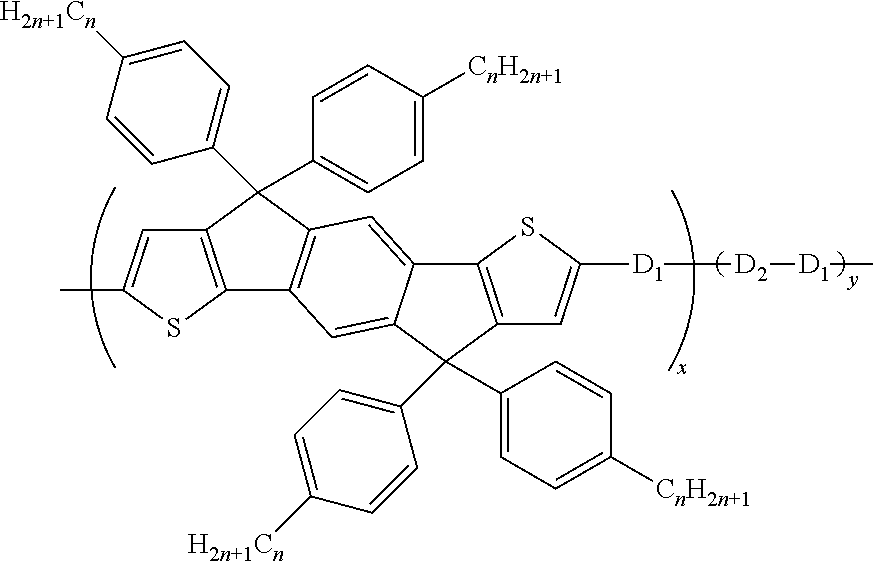Photovoltaic polymer material, preparation method and use thereof
- Summary
- Abstract
- Description
- Claims
- Application Information
AI Technical Summary
Benefits of technology
Problems solved by technology
Method used
Image
Examples
example 1
[0105]The photovoltaic polymer material P (TPT-6-T-BTz-8) of the embodiment of the present invention has the following formula:
[0106]Preparation method of the photovoltaic polymer material P (TPT-6-T-BTz-8) of the embodiment of the present invention comprises the follows steps:
[0107]Under the protection of nitrogen, adding monomer M1, monomer D1a: 2,5-bis(trimethylstannyl)thiophene and monomer D2a-1: 4,7-dibromo-2-n-octyl-1,2,3-benzotriazole into tris(dibenzylideneacetone)dipalladium (5.5 mg, 0.006 mmol), tris(o-methylphenyl)phosphine (14.6 mg, 0.048 mmol) and chlorobenzene (5 mL) according to the molar ratio that monomer M1: monomer D1a: monomer D2a-1 is 1:2:1, mixing, reacting in microwave reactor for 30 min, obtaining dark solution containing photovoltaic polymer material P (TPT-6-T-BTz-8); pouring the dark solution into methanol (1 L), filtrating to obtain black precipitates, extracting from raw product in Soxhlet extractor with methanol, acetone, n-hexane for 24 h, then collect...
example 2
[0108]The photovoltaic polymer material P (TPT-8-T-BTz-6) of the embodiment of the present invention has the following formula:
[0109]Preparation method of the photovoltaic polymer material P (TPT-8-T-BTz-6) of the embodiment of the present invention, referring to Example 1, where molar ratio of monomers that monomer M2: monomer D1a: monomer D2a-2 is 1:3:1, tris(dibenzylideneacetone)dipalladium: tris(o-methylphenyl)phosphine is 1:6.
[0110]The yield is 75%. Molecular weight (GPC, THF, R. I): Mn=37600, Mw / Mn=2.3).
example 3
[0111]The photovoltaic polymer material P (TPT-12-T-BTz-12) of the embodiment of the present invention has the following formula:
[0112]Preparation method of the photovoltaic polymer material P (TPT-12-T-BTz-12) of the embodiment of the present invention, referring to Example 1, where molar ratio of monomers that monomer M3: monomer D1a: monomer D2a-3 is 1:6:2, tris(dibenzylideneacetone)dipalladium: tris(o-methylphenyl)phosphine is 1:3.
[0113]The yield is 85%. Molecular weight (GPC, THF, R. I): Mn=48500, Mw / Mn=1.1).
PUM
| Property | Measurement | Unit |
|---|---|---|
| Temperature | aaaaa | aaaaa |
| Temperature | aaaaa | aaaaa |
| Time | aaaaa | aaaaa |
Abstract
Description
Claims
Application Information
 Login to View More
Login to View More - R&D Engineer
- R&D Manager
- IP Professional
- Industry Leading Data Capabilities
- Powerful AI technology
- Patent DNA Extraction
Browse by: Latest US Patents, China's latest patents, Technical Efficacy Thesaurus, Application Domain, Technology Topic, Popular Technical Reports.
© 2024 PatSnap. All rights reserved.Legal|Privacy policy|Modern Slavery Act Transparency Statement|Sitemap|About US| Contact US: help@patsnap.com










